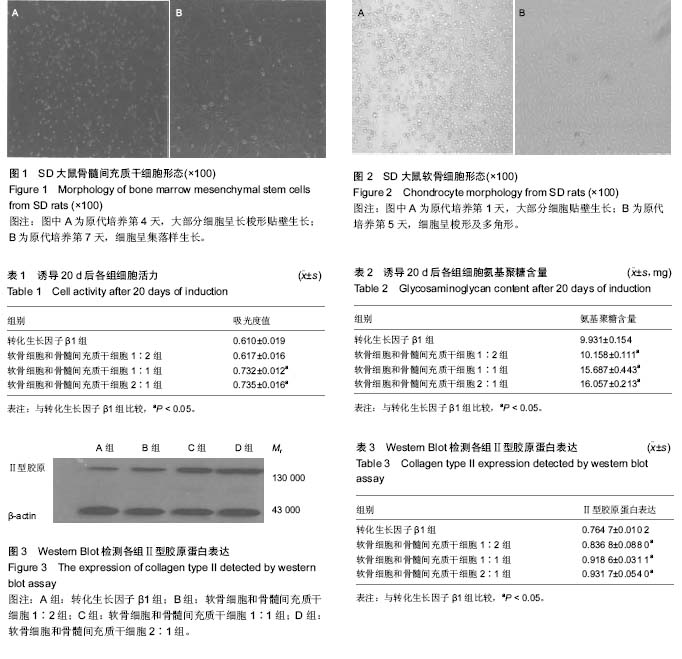| [1] 王万宗,陈宗雄,刘晓强.骨髓间充质干细胞与关节软骨细胞Transwell共培养诱导形成软骨[J].中国组织工程研究与临床康复,2010,14(38):7041-7044.
[2] 陈宗雄,刘晓强,王万宗.骨髓间充质干细胞和关节软骨细胞共培养与转化生长因子β1诱导的比较[J].中国组织工程研究与临床康复,2010,14(27):5037-5040
[3] 崔小明,吴佳奇.骨髓间充质干细胞与软骨细胞共培养研究进展[J].中国综合临床,2015,31(4):366-367,368.
[4] 段小军,杨柳,左镇华,等.应用聚集培养技术进行兔骨髓间充质干细胞体外成软骨诱导培养[J].中华实验外科杂志,2007,24(3): 316-318.
[5] 刘晓强.关节软骨细胞诱导骨髓间充质干细胞向软骨样细胞分化的研究[D]. 福州:福建医科大学,2010.
[6] 李丽艳,黄金中,杜江.转化生长因子β1诱导骨髓间充质干细胞向软骨细胞分化[J].中国组织工程研究与临床康复,2010,14(1): 38-41.
[7] 江祖炘.骨髓间充质干细胞复合改良纤维蛋白凝胶和软骨细胞体外共培养成软骨实验研究[D]. 泸州:泸州医学院,2014.
[8] 林志金.LIPU对兔CFDBM负载关节软骨细胞及BMSCs的作用研究[D].上海:第二军医大学,2010.
[9] 寇建强,王昌耀,王英振,等.外源性透明质酸对兔骨髓间充质干细胞定向分化为软骨细胞的影响[J].中国组织工程研究与临床康复, 2011,15(3):381-385
[10] 华强,吴佳奇,钟传山,等.人关节液促进骨髓间充质干细胞的定向分化[J].中国组织工程研究,2014,18(10):1490-1495.
[11] 郭洪亮,帖小佳,韩亚军,等.定向诱导骨关节炎患者骨髓间充质干细胞向软骨细胞的分化[J].中国组织工程研究,2015,19(6): 832-836.
[12] 田力,范妮娜,田晓晔,等.骨髓间充质干细胞定向诱导移植修复关节软骨[J].中国组织工程研究与临床康复,2009,13(46):9041- 9044.
[13] 林志金,唐昊,沈锋,等.低强度脉冲式超声对兔脱细胞脱钙骨基质负载关节软骨细胞及骨髓间充质干细胞复合体的影响[J].中国组织工程研究与临床康复,2009,13(47):9217-9223.
[14] 冯万文,夏亚一,孙正义,等.骨髓间充质干细胞和软骨细胞共培养复合同种异体脱钙骨基质修复关节软骨全层缺损[J].第四军医大学学报,2006,27(18):1683-1686.
[15] Alfaqeh H, Chua KH, Aminuddin BS, et al. Effects of different media on the in vivo chondrogenesis of sheep bone marrow stem cells: histological assessment. Med J Malaysia. 2008;63 Suppl A:119-120.
[16] 王结果,董展,郑朋飞,等.异种关节软骨与MSCs体外共同培养的实验研究[J].实用临床医药杂志,2010,14(11):12-16.
[17] 夏亚一,冯万文,孙正义,等.自体骨髓间充质干细胞和软骨细胞共培养复合同种异体完全脱蛋白骨修复关节软骨全层缺损的研究[J].中国矫形外科杂志,2006,14(16):1245-1248.
[18] Wang G, Wang L, Li W, et al. In vitro study of the directed inducing cartilage cells from rat bone mesenchymal stem cells on scaffolds. Sheng Wu Yi Xue Gong Cheng Xue Za Zhi. 2005;22(6):1223-1226.
[19] Bi X, Yang X, Bostrom MP, et al. Fourier transform infrared imaging spectroscopy investigations in the pathogenesis and repair of cartilage. Biochim Biophys Acta. 2006;1758(7): 934-941.
[20] 李斌,张伟,王健,等.体外微团培养兔骨髓间充质干细胞形成软骨细胞[J].中国矫形外科杂志,2009,17(23):1819-1822.
[21] 葛薇,姜文学,李长虹,等.骨髓间充质干细胞复合纤维蛋白封闭剂体内构建可注射性组织工程软骨[J].中国修复重建外科杂志, 2006,20(2):139-143.
[22] Wang L, Detamore MS. Effects of growth factors and glucosamine on porcine mandibular condylar cartilage cells and hyaline cartilage cells for tissue engineering applications. Arch Oral Biol. 2009;54(1):1-5.
[23] 孙明林,吕丹,朱雷,等.不同状态软骨细胞在共培养系统下对BMSCs向软骨细胞诱导分化作用的研究[J].中国矫形外科杂志, 2011,19(3):233-237.
[24] McFarlin K, Gao X, Liu YB, et al. Bone marrow-derived mesenchymal stromal cells accelerate wound healing in the rat. Wound Repair Regen. 2006;14(4):471-478.
[25] Connelly JT, Wilson CG, Levenston ME. Characterization of proteoglycan production and processing by chondrocytes and BMSCs in tissue engineered constructs. Osteoarthritis Cartilage. 2008;16(9):1092-1100.
[26] 徐斌,王浩,徐洪港,等.同种异体脱钙骨复合骨髓间充质干细胞在兔膝关节腔内培养组织工程软骨的研究[J].中华实验外科杂志, 2011,28(6):979-982.
[27] 尚平,贺宪,安耀武,等.骨碎补总黄酮对骨关节炎家兔骨髓间充质干细胞软骨定向分化的实验研究[J].生物骨科材料与临床研究, 2009,6(6):10-13.
[28] 孙智.骨髓间充质干细胞与关节软骨修复的研究进展[J].中国综合临床,2011,27(3):330-331.
[29] 杨自权,卫小春,焦强,等.自体骨髓间充质干细胞移植修复兔关节软骨损伤[J].中华创伤杂志,2005,21(3):183-186.
[30] Munirah S, Kim SH, Ruszymah BH, et al. The use of fibrin and poly(lactic-co-glycolic acid) hybrid scaffold for articular cartilage tissue engineering: an in vivo analysis. Eur Cell Mater. 2008;15:41-52.
[31] 姚军,李佳,杜刚,等.纳米微孔聚乙酸内酯联合骨髓间充质干细胞对兔损伤关节软骨结缔组织生长因子蛋白的影响[J].实用医学杂志,2014,30(18):2887-2890.
[32] 刘志强,程红斌,刘建国,等.骨髓间充质干细胞在关节软骨损伤中的应用[J].中国实验诊断学,2012,16(2):373-375.
[33] Chung R, Cool JC, Scherer MA, et al. Roles of neutrophil-mediated inflammatory response in the bony repair of injured growth plate cartilage in young rats. J Leukoc Biol. 2006;80(6):1272-1280.
[34] Sui Y, Clarke T, Khillan JS. Limb bud progenitor cells induce differentiation of pluripotent embryonic stem cells into chondrogenic lineage. Differentiation. 2003;71(9-10):578-585.
[35] Zhang P, Han D, Tang T, et al. Inhibition of the development of collagen-induced arthritis in Wistar rats through vagus nerve suspension: a 3-month observation. Inflamm Res. 2008; 57(7):322-328.
[36] 洪洋,霍建忠,郭常安,等.骨髓间充质干细胞构建组织工程软骨修复兔关节软骨缺损的实验研究[J].中国临床医学,2013,20(4): 457-461.
[37] 田力,汪卓,范妮娜.兔骨髓间充质干细胞定向诱导移植修复关节软骨的实验研究[J].中国医药导报,2008,5(23):16-18.
[38] Quintana DJ, Garnero P, Huebner JL, et al. PIIANP and HELIXII diurnal variation. Osteoarthritis Cartilage. 2008; 16(10):1192-1195.
[39] 赵劲民,韦庆军,许圣荣,等.自体骨髓间充质干细胞复合同种异体脱钙骨基质修复兔关节软骨缺损的初步研究[C].南宁:第二届全国骨科修复与移植学术研讨会论文集,2008:280-284. |
